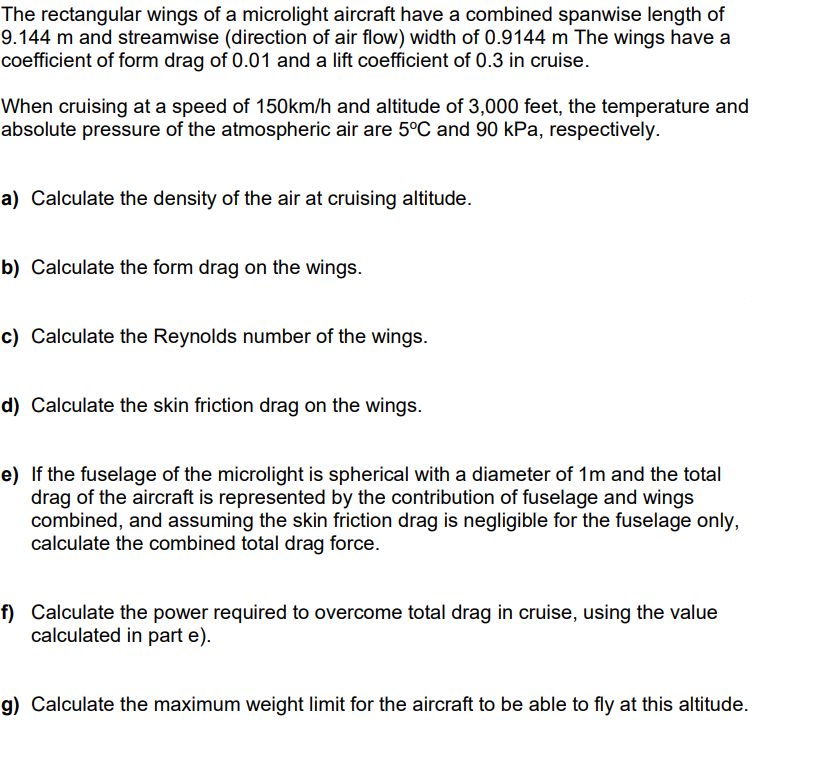The rectangular wings of a microlight aircraft have a combined spanwise length of 9.144 m and streamwise (direction of air flow) width of 0.9144 m The wings have a coefficient of form drag of 0.01 and a lift coefficient of 0.3 in cruise. When cruising at a speed of 150km/h and altitude of 3,000 feet, the temperature and absolute pressure of the atmospheric air are 5°C and 90 kPa, respectively.
The rectangular wings of a microlight aircraft have a combined spanwise length of 9.144 m and streamwise (direction of air flow) width of 0.9144 m The wings have a coefficient of form drag of 0.01 and a lift coefficient of 0.3 in cruise. When cruising at a speed of 150km/h and altitude of 3,000 feet, the temperature and absolute pressure of the atmospheric air are 5°C and 90 kPa, respectively.
Elements Of Electromagnetics
7th Edition
ISBN:9780190698614
Author:Sadiku, Matthew N. O.
Publisher:Sadiku, Matthew N. O.
ChapterMA: Math Assessment
Section: Chapter Questions
Problem 1.1MA
Related questions
Question

Transcribed Image Text:The rectangular wings of a microlight aircraft have a combined spanwise length of
9.144 m and streamwise (direction of air flow) width of 0.9144 m The wings have a
coefficient of form drag of 0.01 and a lift coefficient of 0.3 in cruise.
When cruising at a speed of 150km/h and altitude of 3,000 feet, the temperature and
absolute pressure of the atmospheric air are 5°C and 90 kPa, respectively.
a) Calculate the density of the air at cruising altitude.
b) Calculate the form drag on the wings.
c) Calculate the Reynolds number of the wings.
d) Calculate the skin friction drag on the wings.
e) If the fuselage of the microlight is spherical with a diameter of 1m and the total
drag of the aircraft is represented by the contribution of fuselage and wings
combined, and assuming the skin friction drag is negligible for the fuselage only,
calculate the combined total drag force.
f) Calculate the power required to overcome total drag in cruise, using the value
calculated in part e).
g) Calculate the maximum weight limit for the aircraft to be able to fly at this altitude.
Expert Solution
This question has been solved!
Explore an expertly crafted, step-by-step solution for a thorough understanding of key concepts.
Step by step
Solved in 5 steps

Knowledge Booster
Learn more about
Need a deep-dive on the concept behind this application? Look no further. Learn more about this topic, mechanical-engineering and related others by exploring similar questions and additional content below.Recommended textbooks for you

Elements Of Electromagnetics
Mechanical Engineering
ISBN:
9780190698614
Author:
Sadiku, Matthew N. O.
Publisher:
Oxford University Press

Mechanics of Materials (10th Edition)
Mechanical Engineering
ISBN:
9780134319650
Author:
Russell C. Hibbeler
Publisher:
PEARSON

Thermodynamics: An Engineering Approach
Mechanical Engineering
ISBN:
9781259822674
Author:
Yunus A. Cengel Dr., Michael A. Boles
Publisher:
McGraw-Hill Education

Elements Of Electromagnetics
Mechanical Engineering
ISBN:
9780190698614
Author:
Sadiku, Matthew N. O.
Publisher:
Oxford University Press

Mechanics of Materials (10th Edition)
Mechanical Engineering
ISBN:
9780134319650
Author:
Russell C. Hibbeler
Publisher:
PEARSON

Thermodynamics: An Engineering Approach
Mechanical Engineering
ISBN:
9781259822674
Author:
Yunus A. Cengel Dr., Michael A. Boles
Publisher:
McGraw-Hill Education

Control Systems Engineering
Mechanical Engineering
ISBN:
9781118170519
Author:
Norman S. Nise
Publisher:
WILEY

Mechanics of Materials (MindTap Course List)
Mechanical Engineering
ISBN:
9781337093347
Author:
Barry J. Goodno, James M. Gere
Publisher:
Cengage Learning

Engineering Mechanics: Statics
Mechanical Engineering
ISBN:
9781118807330
Author:
James L. Meriam, L. G. Kraige, J. N. Bolton
Publisher:
WILEY